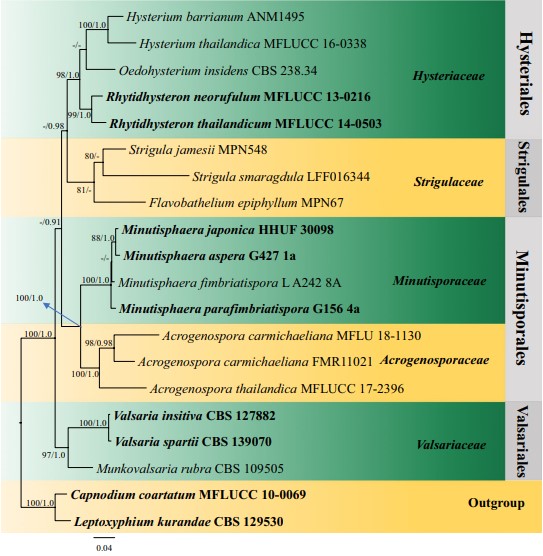Acrogenosporaceae Jayasiri & K.D. Hyde, Mycosphere 9(4): 809 (2018).
MycoBank number: MB 554451; Index Fungorum number: IF 554451; Facesoffungi number: FoF 04575; 13 species.
Saprobic on bark and wood. Sexual morph: Hysterothecia superficial, laterally compressed, thick-walled, with a prominent sunken slit, solitary to gregarious, erect and elevated, presenting an almost pedicellate appearance.
Hamathecium comprising persistent cellular, hypha-like, hyaline, septate, paraphyses. Asci 8-spored, cylindrical to clavate. Ascospores 1–2-seriate, ellipsoidal to fusiform, hyaline or moderately pigmented, 1- or 2-celled, with the septum near the lower end, hyaline or moderately pigmented. Asexual morph: Hyphomycetous. Colonies effuse, scattered, black, glistening, hairy. Mycelium mostly immersed, consisting of septate, subhyaline to pale brown hyphae. Conidiophores macronematous, mononematous, pale to mid brown, often slightly paler at the apex, smooth, septate, unbranched, long cylindrical or slightly tapering towards the apex, straight or slightly flexuous, erect, solitary or in small groups. Conidiogenous cells monoblastic, integrated, terminal or intercalary, light brown or hyaline, cylindrical, often elongated percurrently. Conidia holoblastic, solitary, globose, obovoid to ellipsoidal, asaptate, dark brown to black, smooth or verrucose, truncate at base.
Type genus: Acrogenospora M.B. Ellis.
Notes: Acrogenosporaceae was introduced by Jayasiri et al. (2018) for a single genus Acrogenospora. Based on morphological characters and phylogenetic analyses, Acrogenosporaceae was placed within Minutisphaerales as a sister clade to the type family Minutisphaeraceae (Jayasiri et al. 2018). This study further supports the earlier result (Fig. 46). Descriptions and illustrations of the sexual morphs of Acrogenosporaceae can be seen in previous studies (i.e. Greville 1825; Duby 1862; von Arx and Müller 1975).

Fig. 46 Phylogram generated from maximum likelihood analysis (RAxML) of Minutisphaerales based on ITS, LSU, SSU and tef1 sequence data. Maximum likelihood bootstrap values equal or above 70%, Bayesian posterior probabilities equal or above 0.90 (MLBS/ PP) are given at the nodes. An original isolate number is noted after the species name. The tree is rooted to Capnodium coartatum (MFLUCC 10-0069) and Leptoxyphium kurandae (CBS 129530). The ex-type strains are indicated in bold. Hyphen (-) represents support values below 70% MLBS and 0.90 PP
Genera
